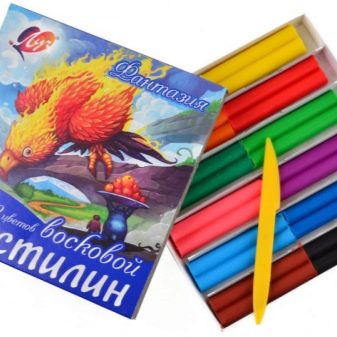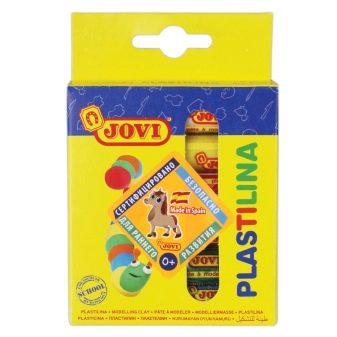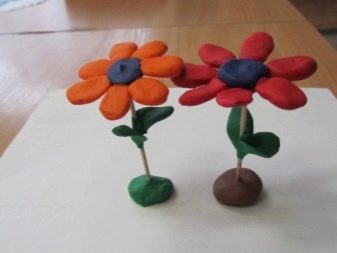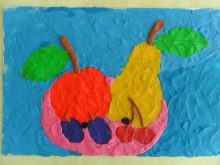Plasticine modeling for children 3-4 years old

Educators, pediatricians and psychologists advise to engage in modeling with children from a very early age. This is the best way to develop fine motor skills, speech skills, as well as perseverance, imagination and attention in a baby. Let's get acquainted in more detail with the features of modeling for children 3-4 years old.






Basic techniques
It has been proven that fine motor skills of the hands have a great influence on the development of speech skills and the enrichment of a child's vocabulary. Sculpting is one of the best ways to strengthen the muscles of your baby's arms and, accordingly, improve his thinking and speech. Working with plasticine forms in young children a sense of form, color, imagination and composition skills. Acquaintance with the mass for modeling can begin as early as one year of age, and at 3-4 years old, such classes should be included in the mandatory list of creative works by the kid.


The benefits of sculpting are invaluable.
- The development of fine motor skills. The area of the brain responsible for the formation of the speech apparatus is located directly near the area responsible for the motor skills of the fingers. Thus, stimulation of this area will entail stimulation of the adjacent one. It has been noticed that guys who constantly do something with their hands are much less likely to encounter speech problems.
- Development of tactile sensitivity and touch. By the age of three, children usually have time to touch a lot of things, and the time comes when, based on tactile memory, they need to learn to recreate the configuration and texture of various objects. Subsequently, this skill will allow them to identify the necessary items by touch.
- Development of memory and fantasy... Sculpting from memory helps to stabilize neural processes in the cerebral cortex. By recreating plasticine figures of animals, the child trains memory, and at the same time develops imagination.
- Perseverance... Modeling captivates the kid, but it takes time, concentration and scrupulousness. These skills will help your toddler to cope with long school hours without any problems.
- Accuracy... Modeling from plasticine teaches the kid to be neat, to maintain cleanliness and order in his workplace.
At 3-4 years old, much attention is paid to sculpting by templates. To begin with, children study objects that they will sculpt, and then copy. At this point, you need to teach the kid a few basic techniques for working with plasticine.


Rolling out
This technique can be straight or circular. Logs, sausages and posts can be made using direct rolling. Circular rolling is useful when creating rounded objects.

Kneading
Basic technique when working with plasticine. Before proceeding with the creation of figures, the kids need to be given a block in their hands, to acquaint the child with all the features and properties of plasticine. It is very important at this moment to show the guys that soft plasticine can change shape and allows you to mix different shades.

Flattening
This technique is used to create flat parts. Flattening is performed by squeezing a piece of plasticine between palms, fingers, or by pressing it against the table. However, it is important to teach the child not to press too hard, otherwise it will be difficult for him to separate the mass for subsequent work.

What is necessary?
There are many varieties of plasticine in stores these days. The classic modeling mass, which was also used by our mothers and fathers, is considered universal. The most popular brands in this series are "Luch" and "Gamma" - for several decades they have not given up their positions... It is cheap stuff and environmentally friendly... However, it is quite tough, so you have to warm it up a little before work so that children 3-4 years old can knead it properly.


Wax plasticine is very popular. It is very plastic, it crumples well in fragile hands, so babies from a year can deal with it. The individual elements adhere well to each other - which is extremely important for young creators. The advantages of the material also include its environmental friendliness.


Plant-based plasticine is more of a modeling paste. It has a rich color range and a softened structure, and besides, it mixes well. You can work with such plasticine from a very early age. The only drawback is that the parts do not adhere well to each other.


Not so long ago appeared on the market ball plasticine... It is easy to create any shape from this mass. Its elements adhere well to each other, so it is not difficult to create the desired shape.
The craft can be left for a day - it will become solid in the fresh air. Such a sculpture can be stored for a long time, so it can be used as a decoration for a child's room. However, playing with such a toy will not work, since after solidification the mass becomes quite fragile.



In recent years, a large assortment of innovative plasticine has appeared in stores.
- Gum Is a polymer mass that does not stick to hands. She has unusual characteristics. If you mold a small ball and leave it on the table, it will soon transform into a puddle. And if you throw him on the floor with force, he jumps like a bouncing bouncer. Some products glow in the dark and even magnetise.
- Eraser - you can mold any figure from this plasticine, and then cook it in boiling water. The child will receive the most ordinary hand-made eraser.
- Plasticine soap - if you sculpt a figurine from this unusual mass, then it will wash under the influence of water.This can be a good help in the difficult task of accustoming your baby to hygiene.



All varieties of plasticine for children have a safe composition. Therefore, if you feel that the bars have a pronounced chemical smell, then it is better to refuse such a product.
In addition to plasticine, for modeling you need to prepare plank and stacks. It is advisable to take plastic products, since they are easier to care for. It should be borne in mind that all types of plasticine, with the exception of chewing gum, have a detrimental effect on carpets, clothing and upholstered furniture. A 100% effective way to remove melted plasticine from soft surfaces has not yet been invented, and the advertised use of acid and frost does not work in practice. It is advisable to organize a place for sculpting where contact with such coatings is minimized. The optimal work area will be a flat surface without pillows, rugs, carpets and fabric-covered chairs.


How to make animal figures?
Children 3-4 years old usually like to sculpt figures of funny animals from plasticine. Let's take a look at how to fashion the simplest animals step by step.
Caterpillar
To make an unusual caterpillar, you need to roll several balls of the same size. They can be solid or multi-colored. After that, it remains only to fasten them together. To make it more realistic, eyes are attached to the front ball and make a mischievous smile.




bear
Roll one large ball out of dark brown plasticine - this will be the body. A slightly smaller ball will become a head, four more small lumps will act as paws. You will also need three tiny balls - they will go to the ears and tail.
Roll the muzzle out of light plasticine. Make three balls of black plasticine - two of them will go to the pupils, and the third will become the nose. The belly of a bear is made from a flattened yellow or white ball.
When all the details are ready, you can assemble the bear. For greater reliability, the head is placed with a torso with a toothpick, the rest of the elements are simply attached. If you wish, you can dress your Mishutka, for example, mold a hat or a scarf for him.

Dinosaur
Roll a thick, thick sausage out of blue, green or purple plasticine, then stretch a thinner tail a little and make a neck. Select the head from the same sausage. Using a plastic knife, form a mouth and insert a triangle of red or orange plasticine into it.
Attach the eyes a little higher. Make a comb out of the small yellow triangles. Form the sausages for the legs - they are attached to the body, carefully smoothing out the joints.





Giraffe
Use orange plasticine to make a thick sausage. Gently pull the long neck out of it and bend it over in the form of a head.
Use a stack to form a mouth and insert a small pink plasticine cake. Above, pin the black and white eyes.
From the yellow mass, bend the sausage in the form of horns, fix the balls of light brown color at the ends. The legs are formed from a yellow sausage, the hooves are decorated with a brown ribbon.
Form a thin rope of brown plasticine, stick it to the back, gently flatten and smooth. Use the stack to form serifs along the length. Secure the tail. Make small spot cakes from black plasticine. Stick them all over the giraffe's body.

Small fish
Pinch off a small piece of plasticine. Knead it thoroughly, roll it into a ball, and then stretch it slightly until it reaches an oval. If desired, the oval can be slightly flattened, this will make the body of the fish flatter and give the maximum resemblance to a real aquatic inhabitant. Form several triangles from plasticine of a different color - these will be the fins and tail of the fish.
Make fish eyes out of black balls, if there is no plasticine, you can draw them with a stack. If desired, the body can be decorated with imitation scales... To do this, you will have to make many small balls, flatten them with your fingers and fix them on the body.

If you use plasticine mass for modeling, which dries in air, then later it can be painted with felt-tip pens or paints.
This is just a small list of those animals that can be molded from plasticine with a baby 3-4 years old. If you wish, you can make a bunny, a cat, a chanterelle, a walrus, as well as interesting insects - bugs, spiders, ants and ladybugs.



How to make New Year's toys?
You can roll a snowman out of plasticine very simply and quickly. To do this, you need three balls - large, medium and slightly smaller than average. Additionally, you need to make two small balls - they will act as hands. Two more small pieces will go to the eyes.
From the red mass, form a flagellum for a smile and a carrot-shaped cone. It remains only to connect all the elements together. A branch is inserted into the hands of the mischievous snowman. Put any bucket on your head. It can be formed from plasticine of any arbitrary color or use a cream lid.

Simple DIY flowers
A very beautiful mini-flower bed can be assembled from plasticine together with a child of 3-4 years old. To do this, take the lid from the jar and fill it with a brown mass. On a blue cake, 5-6 circular serifs are formed using scissors - they should look in the same direction. In the other direction, make a few more cuts and cut out the petals.
After that, you need to glue the round yellow center and bend the petals. To make a stalk, coat the match with green plasticine. At one end it is connected to a flower, the other is planted in a flower bed. In order for the flowerbed to turn out beautiful, it is necessary to prepare several flowers.


Modeling other crafts
You can not only sculpt from plasticine, you can also draw with it. This technique even got its name - plasticineography. It involves smearing the plastic mass on the paper. In order to make a drawing, you need to place a small piece of modeling mass on the paper and stretch it with your fingers from one contour to another.
Plasticine art is a very useful activity. She prepares the hand of the crumbs for the letter. By the way, teachers recommend this method for acquainting a child with letters. However, in this matter, the children will need the help of their parents, who will direct the movements of the crumbs.



Crafts from the mass for modeling and natural materials are very interesting. So, from chestnuts you can collect a cheburashka, a bear, a bunny and a snail. And if you take a peel with thorns, you get an excellent hedgehog. Cones and plasticine make a good squirrel or unicorn. And acorns can be taken for sculpting penguins.




It is imperative to show your child how much you value their creativity, so try to keep the figurines safe and sound.
In the case of paintings, everything is simple - they can be hung on the wall or, by shifting with paper, placed for storage in a voluminous folder. When storing figures, certain difficulties can arise. The ideal solution would be to place them in separate cardboard cells - this way the products will not melt, become covered with dust or break. And if you do not want to hide them from your eyes, then it is better to put them on a glazed shelf. They can become a real decoration of a child's room.

About plasticine modeling for children 3-4 years old, see the video.








